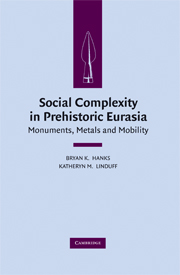Book contents
- Frontmatter
- Contents
- Contributors
- Foreword: From Myth to Method: Advances in the Archaeology of the Eurasian Steppe
- CHAPTER 1 Introduction: Reconsidering Steppe Social Complexity within World Prehistory
- PART ONE FRAMING COMPLEXITY
- CHAPTER 2 Introduction
- CHAPTER 3 Differentiated Landscapes and Non-uniform Complexity among Bronze Age Societies of the Eurasian Steppe
- CHAPTER 4 The Sintashta Genesis: The Roles of Climate Change, Warfare, and Long-Distance Trade
- CHAPTER 5 Settlements and Cemeteries of the Bronze Age of the Urals: The Potential for Reconstructing Early Social Dynamics
- CHAPTER 6 The Maikop Singularity: The Unequal Accumulation of Wealth on the Bronze Age Eurasian Steppe?
- PART TWO MINING, METALLURGY, AND TRADE
- PART THREE FRONTIERS AND BORDER DYNAMICS
- PART FOUR SOCIAL POWER, MONUMENTALITY, AND MOBILITY
- Index
CHAPTER 2 - Introduction
from PART ONE - FRAMING COMPLEXITY
Published online by Cambridge University Press: 26 January 2010
- Frontmatter
- Contents
- Contributors
- Foreword: From Myth to Method: Advances in the Archaeology of the Eurasian Steppe
- CHAPTER 1 Introduction: Reconsidering Steppe Social Complexity within World Prehistory
- PART ONE FRAMING COMPLEXITY
- CHAPTER 2 Introduction
- CHAPTER 3 Differentiated Landscapes and Non-uniform Complexity among Bronze Age Societies of the Eurasian Steppe
- CHAPTER 4 The Sintashta Genesis: The Roles of Climate Change, Warfare, and Long-Distance Trade
- CHAPTER 5 Settlements and Cemeteries of the Bronze Age of the Urals: The Potential for Reconstructing Early Social Dynamics
- CHAPTER 6 The Maikop Singularity: The Unequal Accumulation of Wealth on the Bronze Age Eurasian Steppe?
- PART TWO MINING, METALLURGY, AND TRADE
- PART THREE FRONTIERS AND BORDER DYNAMICS
- PART FOUR SOCIAL POWER, MONUMENTALITY, AND MOBILITY
- Index
Summary
In the past few years, several international conferences in the United States (e.g., Chicago 2004; Pittsburgh 2006) have focused on the problems of social complexity in the vast region of Eurasia. I remember that during my first trip to the United States in 1994, I met David Anthony, Karen Rubinson, Adam Smith, Phil Kohl, and Karlene Jones-Bley. At that time, these individuals were representative of a very small group of American archaeologists whose academic interests were directed to a better understanding of Eurasian steppe prehistory. In retrospect, it has taken some time to overcome the consequences of the long academic separation that existed between Anglo-American and Russian archaeology during the Soviet period. In recent years, the beginning of a much better understanding between scholars of these regions and broader perceptions of Eurasian archaeological materials are being realized.
Both past and recent research has shown that Eurasian prehistory represents a number of socio-cultural phenomena not only of regional but also of wider historical significance. The assessment of these phenomena, particularly the character and level of social complexity of Eurasian cultures in light of modern theoretical models, forms a rather new agenda in Eurasian studies. This volume, and the set of essays that forms part I, contribute importantly to this new orientation.
All of the chapters in the first part focus on the Bronze Age. Geographically, three of the four papers fully or partly concern the Ural mountain region (Epimakhov, Anthony, Frachetti), one paper the Caucasus (Kohl), and another also includes the Semirech'ye area of southeastern Kazakhstan (Frachetti).
- Type
- Chapter
- Information
- Social Complexity in Prehistoric EurasiaMonuments, Metals and Mobility, pp. 11 - 18Publisher: Cambridge University PressPrint publication year: 2009



